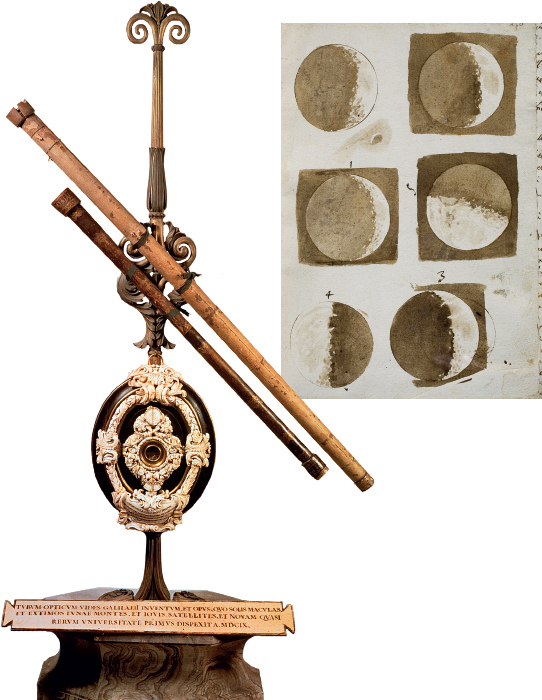Understanding World Societies:
Printed Page 553
Chapter Chronology
Astronomy and Physics

Galileo’s Telescopic Observations of the Moon
Among the many mechanical devices Galileo invented was a telescope that could magnify objects twenty times (other contemporary telescopes could magnify objects only three times). Using this telescope, he obtained the empirical evidence that proved the Copernican system. He sketched many illustrations of his observations, including the six phases of the moon, two of which are shown here. (moon: Biblioteca Nazionale, Florence, Italy/Rabatti-Domingi/akg-images; telescope: Museo delle Scienze, Florence, Italy/akg-images)
The first great departure from the medieval understanding of cosmology was the work of the Polish cleric Nicolaus Copernicus (1473–1543). Without questioning the Aristotelian belief in crystal spheres, Copernicus theorized that the stars and planets, including the earth, revolved around a fixed sun. Fearing the ridicule of other astronomers, Copernicus did not publish his On the Revolutions of the Heavenly Spheres until 1543, the year of his death.
One astronomer who agreed with the Copernican hypothesis was the Danish astronomer Tycho Brahe (TEE-koh BRAH-hee) (1546–1601). Brahe established himself as Europe’s leading astronomer with his detailed observations of a new star that appeared suddenly in 1572 and shone very brightly for almost two years. The new star, which was actually a distant exploding star, challenged the idea that the heavenly spheres were unchanging and therefore perfect. For twenty years Brahe observed the stars and planets with his naked eye in order to create new and improved tables of planetary motions.
Brahe’s assistant, Johannes Kepler (1571–1630), used Brahe’s data to develop three revolutionary laws of planetary motion. First, he demonstrated that the orbits of the planets around the sun are elliptical rather than circular. Second, he demonstrated that the planets do not move at a uniform speed in their orbits. When a planet is close to the sun it accelerates, and it slows as it moves farther away from the sun. Finally, Kepler’s third law stated that the time a planet takes to make its complete orbit is precisely related to its distance from the sun. Kepler’s contribution was monumental. Whereas Copernicus had speculated, Kepler used mathematics to prove the precise relations of a sun-centered (solar) system.
While Kepler was unraveling planetary motion, a young Florentine named Galileo Galilei (1564–1642) was challenging Aristotelian ideas about motion on earth. Galileo focused on deficiencies in Aristotle’s theories of motion. He measured the movement of a rolling ball across a surface, repeating the action again and again to verify his results. In his famous acceleration experiment, he showed that a uniform force — in this case, gravity — produced a uniform acceleration. Through another experiment, he formulated the law of inertia. He found that rest was not the natural state of objects. Rather, an object continues in motion forever unless stopped by some external force. His discoveries proved Aristotelian physics wrong.
On hearing details about the invention of the telescope in Holland, Galileo made one for himself in 1609. He quickly discovered the first four moons of Jupiter, which clearly demonstrated that Jupiter could not possibly be embedded in an impenetrable crystal sphere as Aristotle and Ptolemy maintained. This discovery provided concrete evidence for the Copernican theory.
